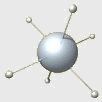The object in Constructivist art appears as simplified and abstract and is not recognized as a "thing," but as a form. Suprematism took these ideas to a further level by focusing on pure geometric forms. The use of basic geometric shapes, such as a square, circle, rectangle, in combination with basic colors, such as red, black and white, became the most well known characteristic associated with the Suprematist movement and its founder, Kazimir Malevich. According to his follower El Lissitzky, "a new era had originated in 1913, at the moment when Malevich created the black square, the 'zero point of painting, the absolute contrast to the old concept of art and painting.'" [4]
This new form of painting can also be approached in terms of the role that technology played within the cultural and historical context of the time period. As Billy Klüver pointed out in 1966, the art world, inspired by the industrial revolution, "embraced technology as subject matter: the enthusiasm of the Futurists, the experiments of Dada, the optimism of the Bauhaus movement and the Constructivists, all have looked at technology and science and found materials for the artists. But for all this interest, art remains a passive viewer of technology. […] The new interface is one in which the artist makes active use of the inventiveness and skills of an engineer to achieve his purpose." [5]
Flash software was developed in the late 90s, at a time when the World Wide Web was continuously growing and new forms of digital media were emerging. With their product Flash, Macromedia successfully fulfilled a need for tools to easily create media content. Computer-generated graphics could exhibit expressions of movement without requiring "hand-made" animation and with only a few lines of code ready-made by Macromedia. One effect produced by Macromedia's new release was the blurring of boundaries between artists and programmers, which significantly increased the number of "digital artists." The creation of net art and "interactive multimedia" suddenly became more feasible for a massive number of "producers," and the results of their endeavors virally spread through the Web. Before long, there were Flash Art competitions; art organizations, software companies, and individuals created their portals and online galleries by means of Flash. The (online) art world had to face the question whether a new generation of Digital Art was born. In one of his articles, Lev Manovich described the phenomenon as the "Flash Generation": "This generation does not care if their work is called art or design. This generation is no longer is interested in 'media critique,' which preoccupied media artists of the last two decades; instead it is engaged in software critique. This generation writes its own software code to create their own cultural systems, instead of using samples of commercial media." [6]
It has to be pointed out here that this essay focuses on Flash as one of the most common tools for the creation of abstract, vector-based motion graphics. However, the subject is not the tool itself, but the analysis of the, to a certain degree standardized, forms it produces. The same graphics could be created in programming languages such as Java and C, but Flash was one of the first software tools that made the production of graphics and animation more accessible to a general audience.
It is interesting to note the parallels between the art objects produced by Suprematism and the Flash Generation -- they are similar in visual terms but could not be more different in their respective contexts and the ways in which they are created. In the following, I would like to concentrate on different characteristics of these parallels, such as form, color and motion (which exists only as concept in Suprematist works) and their context.
Historical, Theoretical, Cultural Context: Revolutions as Art-Driving Events
The influence of technological and historical events on art has been a much-discussed topic in art history. Artists have always been among the first to react to cultural changes and to be inspired by them. The Soviet revolution in Russia, for example, led -- according to Trotsky -- "to the victory of the proletariat, the victory of the proletariat is leading to the transformation of the economy. The transformation of the economy is in process of changing the cultural state of the working masses. And the cultural world of the working people will create a new basis for a new art." [7] Similar to the way in which modern art movements such as Constructivism and Suprematism were reactions to the Industrial Revolution of the 19th century and the later Soviet Revolution of 1917, Digital Art -- admittedly a hybrid practice that cannot be considered a movement per se -- has been a response to the late 20th century electronic revolution. In 1986, Langdon Winner was trying to find the right definition for this revolution: "Often it is called simply 'the computer revolution.' […] Other popular variants include the 'information revolution,' and 'network revolution.' But whatever its label, the message is usually the same. The use of computers and advanced communications technologies is producing a sweeping set of transformations in every corner of social life." Computer scientists emphasize the influence of the Information Revolution, "in which the computer is going to affect us very profoundly, probably more so than the Industrial Revolution." [8]
The new forms of technology that affected such wide spectrums of our lives obviously would not leave the art world unchanged. Roy Ascott points out that "historically it has been a characteristic of the artist to reach out to the tools and materials which the technology of his time produces, just as his perception and patterns of thought have tended to identify with scientific and philosophical attitudes of the period." In the post-industrial revolution era, art was inspired by "machines," which were used as a tool and an object; in the new digital era, "the computer is the supreme tool that its technology has produced." [9]
While Constructivists represented industrial, technological forms as art and used industrial materials (metal, glass) to create art objects, digital artists make use of computers and electronic devices to create and represent art objects. Digital art is not only created by means of different kinds of machines -- such as computers and digital video and sound devices -- but is also presented on these machines.
As if predicting the future of digital art, Malevich wrote in a letter to Dutch artists in 1921, "art has once again met the figurative world of motors and machines, the world of technology, which it must destroy as it did the figurative world of academic arts, and only then will come the true form of the new world." [10] As technology changed the art world in the beginning of the 20th century, digital technologies are changing contemporary artistic practice, which uses and deconstructs them in order to create "new forms."
Artists were always profoundly influenced by revolutions but, as the history of the 20th century shows, revolutions involving "machines" seem to have had a particularly strong effect. Norbert Wiener states that "the first industrial revolution represented the replacement of the energy of man and of animals by the energy of the machine." By contrast, "the new industrial revolution which is taking place now consists primarily in replacing human judgment and discrimination at low levels by the discrimination of the machine." Wiener points to a change in the status of the machine -- as a "source of control and as a source of communication." [11]
The Industrial Revolution affected all forms of the arts, creating numerous movements and defining new standards for judging art. The electronic revolution created a digital art scene that used different media to define new forms of art. Christiane Paul describes the "digital revolution" of the 1990s: "Even though the foundation of many digital technologies had been laid up to 60 years earlier, these technologies became seemingly ubiquitous during the last decade of the twentieth century. […] Artists have always been among the first to reflect on the culture and technology of their time, and decades before the digital revolution had been officially proclaimed, they were experimenting with the digital medium." [12]
The industrial and the digital revolution, respectively, changed the modern arts dramatically, opened up new dimensions and introduced new forms of art objects and their representation. The use of the machine not only as an object but also as a co-creator brought about seemingly endless possibilities.
The Supreme of The Non-Objective World
For a better understanding of the parallels between Suprematism and the abstract, vector-based motion graphics of Flash, one needs to look at the different art processes that characterized these two different forms. Suprematism is the last reincarnation of a process of simplifying form that surfaced in Impressionism, Divisionism, Cezanneism, and Cubism. In The Non-Objective World -The Manifesto of Suprematism, Malevich made one of the most powerful statements on art when he described how new movements cancel out existing "art norms": "For the public (the majority of people) Rembrandt represents the normal in painting; Rembrandt is therefore the 'decisive standpoint' from which a pictorial norm is evaluated. Cubism, to the public, is abnormal because it contains a new additional element -- it signifies a new state of affairs in the compositional relationship of the straight line to the curve -- a new norm." [13] Form, light, and "reality" stopped existing in the way they were previously known to the public, and in Suprematism, they stopped existing at all. The "non-objective" art of Malevich was most radical.
In 1915, Rozanova, one of the "Supremus" group members, had already professed that "objectness and nonobjectness (in painting) are not two different tendencies within a single art, but two different arts -- I even think it's sensible to substitute projections on a screen for paint in nonobject art." [14] Rozanova's statement could also be applied to the non-objectness of digital art. Apart from the fact that projection is one of the (most) common presentation formats of digital art, the latter raises numerous other questions regarding the non-object character of art. Issues of objectness and non-objectness already informed the early years of digital art, which have to be seen in the context of the dematerialization of the art object in the conceptual art of the 1960s and the emergence of "electronic," video art in the 1970s. As a "motion picture" of reality, video still had its source in the world of objects. "3D art" took a big step forward in terms of creating a "new reality," but this reality was also still mostly based on objects, trying to imitate the real world with ready-made, computer-based tools. The appearance of abstract, vector-based motion graphics detached the digital art space from reality and the object world and created new norms of aesthetic simplicity that were not based on representation of the physical world. This new, non-object world was radical in the same way as the Suprematist paintings of Malevich "took the next step […] by abstracting the primary elements of painterly structure, particularly color and form: Through Cubism and Futurism, the artist burst with a convulsive movement into the freedom of pure creativity, into the study of pure painting -- color. Painting is only color and form." [15]
In a similar way, abstract vector-based graphics can consist of only color and form but convey messages and ideas. Manovich describes this new creative process as re-usage of "the language of modernist abstraction and design -- lines and geometric shapes, mathematically generated curves and outlined color fields -- to get away from figuration in general, and cinematographic language of commercial media in particular. Instead of photographs and clips of films and TV, we get lines and abstract compositions. In short, instead of QuickTime, we use Flash." [16]
Create, Don't imitate!
As Malevich states in his Manifesto of Suprematism, "The 'thing' (the nose, the eye, etc.) is raised to the criterion by which an artistic (pictorial) representation is judged and thus the singular opinion of the public that art is not creative but imitative is clearly expressed." [17] Malevich's critique of an aesthetic imitation of reality suggested different ways of representing "reality" -- for example by canceling out all known objects and creating new ones, simple and unique. These objects could convey the spiritual meaning he was striving to capture and thus represent his ideas of pure art -- art not driven by the reality of the object world but by the artist and his ideas. By creating his own scale of geometrical objects, not associated with any particular idea, he could imbue objects with the meaning he wanted to create for them. As Vasilii Rakitin puts it: "Its [Suprematism's] language was like the language of icons, in that icon painting is taught and the understanding of its spirituality comes later; the Suprematists' composition, once it had achieved the status of a sign, would also acquire meaning." [18]
One could argue that some of these ideas are still relevant when it comes to abstract motion graphics in digital art. While artists kept representing or imitating reality in different ways by means of tools such as video and 3D, they also explored how new forms of visual language could be developed on the basis of mathematics and algorithms without referents in the object world. (These explorations also connect to the abstract animations of artists such as Oskar Fischinger or the early -- still largely analogue -- "computer graphics" of John Whitney.) Defining the language of new media, Manovich states that "a new media object can be described formally (mathematically). For instance, an image or a shape can be described using a mathematical function." [19] [Fig. 1 and 2]
 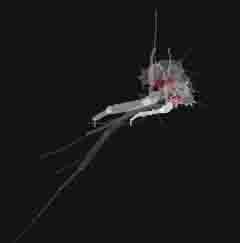
Fig. 1 and 2. Manuel Tan, Uncontrol.com
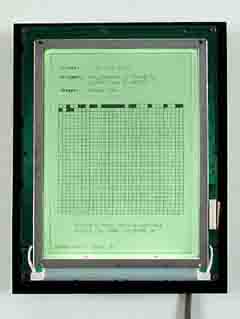 In his project Every Icon [Fig. 3], John F. Simon Jr. wrote software to create a piece of conceptual art that attempts to describe every possible image. The piece consists of a 32 x 32 square grid (the standard "measurement" of an icon), every square of which can be colored black or white. Every Icon starts with an image where all the squares are white, and the software progresses through combinations of black and white squares -- representing all possible icons -- until all the squares are black. (It takes 5.85 billion years to display all variations of the second line of the grid alone). One could argue that the shapes of Every Icon, created by a computer on the basis of mathematical function, are taking Malevich's ideas of the supreme to the next level: is there anything more "supreme" than the black square created by the code executed by a machine? In his project Every Icon [Fig. 3], John F. Simon Jr. wrote software to create a piece of conceptual art that attempts to describe every possible image. The piece consists of a 32 x 32 square grid (the standard "measurement" of an icon), every square of which can be colored black or white. Every Icon starts with an image where all the squares are white, and the software progresses through combinations of black and white squares -- representing all possible icons -- until all the squares are black. (It takes 5.85 billion years to display all variations of the second line of the grid alone). One could argue that the shapes of Every Icon, created by a computer on the basis of mathematical function, are taking Malevich's ideas of the supreme to the next level: is there anything more "supreme" than the black square created by the code executed by a machine?
Analysis & Synthesis: The "Non-Objective" Library
In order for the machine to "create" along with the artist, basic forms, such as lines and shapes, need to be defined to produce unique "new media objects." These basic forms can either be "hand-coded" by the artist or produced in a process of selection from the set of tools provided by software such as Flash. According to Manovich, "selecting ready-made elements to become part of the content of a new media object is only one aspect of the 'logic of selection.'" The application of filters and "effects" in general is based on the same general principle: "All these filters, whether manipulating image appearance, creating a transition between moving images, or applying a filter to a piece of music, involve the same principle: the algorithmic modification of an existing media object or its parts." [20]
The same object can be manipulated in different ways by creating a library of symbols that allows for the recycling of these graphic symbols (duplicating) and the use of different effects for each duplicated object, for instance transforming or skewing. All of these are widely used in vector-based motion graphics. Suprematists duplicated objects and re-used them in a very similar way, creating a "language of icons" or "library of symbols." [Fig. 4 and 5]
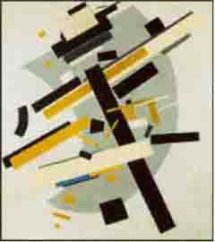 
Fig 4. Kazimir Malevich, Supremus-58, 1916 | Fig 5. Joshua Davis, Praystation.net, 2000
Fig. 6. Kazimir Malevich, Black Square, 1913 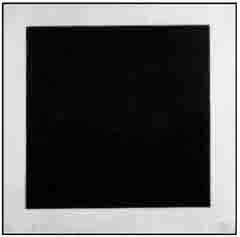 The Color Palette
The Color Palette
The concept of simplicity, or purism, also surfaces in the color palette of Suprematism and Flash. What Malevich defines as the pure, unmixed color characterizing Suprematism, is used in Flash as a flat color filling for shapes. The suprematist palette of basic colors, such as black, white and red, is used as filling for the shapes placed on the white canvas, without creating three-dimensional environments. Light does not exist in the non-objective world of Malevich, in the same way as it does not exist in Flash software. [Fig. 6 and 7]
Manovich comments on contrast and legibility when he describes his first visit to the Flash-based website Praystation.net: "I was struck by the lightness of its graphics. More quiet than whisper, more elegant than Dior or Chanel, more minimal than 1960s minimalist sculptures of Judd, more subdued than the winter landscape in heavy fog, the site pushed the contrast scale to the limits of legibility [...] the contrast with screaming graphics of commercial media and the media art of the previous generations is obvious." [21]

Fig 7. Joshua Davis, Praystation.net
The Loop
The element of movement and rhythm played a significant role in suprematist painting: without actually moving any objects, Suprematists suggested movement to the viewer by creating dynamic compositions that referenced the technological revolution as well as the motion picture. As Malevich puts it, "The suprematist square and the forms proceeding out of it can be likened to the primitive marks (symbols) of aboriginal man which represented, in their combinations, not ornament but a feeling of rhythm." [22] Through the evocation of rhythmic movement, suprematist paintings actually created a form of "looping" that occurs in the viewer's imagination while looking at the work.
There is evidence that "Lissitzky had contemplated animating his abstract compositions as early as 1922." Russian Art critic Nikolai Khardzhiev describes Lissitzky's book About Two Squares as "an animation… where all the 'stills' are connected by an undisturbed movement of simple, equivalent figures within a time sequence, which is finalized with the triumph of the Red square." [23]
While it would have taken Lissitzky considerable effort to realize his suprematist film in 1922, any new media object can today be moved by a few lines line of simple code, creating a loop -- a basic structure of code as Manovich points out: "Programming involves altering the linear flow of data through control structures, such as 'if/then' and 'repeat/while'; the loop is the most elementary of these control structures." [24]
The loop is a default movement option for a Flash movie, part of the ready-made code that actually defined the character of most Flash-created pieces and became a lead component of interactivity: the Flash movie loops until it is stopped by the user's action. The painted form moves as long as the viewer looks at the painting. The movement that Suprematists were trying to create by using compositions of particular shapes and forms became a main "theme" in "Flash art." Each Flash movie usually consists of a number of different loops or independent objects that are looping by default as part of the software code. The animation is created by the code that defines the actual movement on the screen (not by the viewer's imagination), which contributes to defining the aesthetics of the work.
Conclusion
While Suprematism and Flash's abstract motion graphics flourished in radically different time periods, they nevertheless share at least some similar concepts. Both responded to the "revolutions" of their time -- the Industrial, the Soviet, the Digital -- and their different technological "tools," Suprematism in its forms and the Flash Generation in its conventions for the creation and presentation of abstract motion graphics; both were influenced by technological changes and developed similar aesthetic norms; both were responses to long traditions of object-based representations and employed a simplicity of form and color to create non-object worlds as carriers of creative concepts.
Looking back to the beginning of the 20th century, one can still perceive Suprematism's metaphysical vision as impressive in its precision for defining colors, forms, and rhythms, which became basic standards for graphic art and for the abstract, vector-based motion graphics that were popularized thanks to Macromedia Flash.
I am not proposing that Macromedia should give credit to Kazimir Malevich in their software license, but it is indubitable that the first "new media object" that I (as most Flash users) created with Flash was a black square on a white background.
References
[1] Vector graphics or geometric modeling is the use of geometrical primitives such as points, lines, curves, and polygons to represent images in computer graphics. It is used by contrast to the term raster graphics, which is the representation of images as a collection of pixels (dots).
[2] Christina Lodder, "El Lissitzky and the export of Constructivism" in: Nancy Perloff and Brian Reed (eds.), Situating El Lissitzky - Vitebsk, Berlin, Moscow (Getty Trust Publications: Getty Research Institute for the History of Art and the Humanities, 2003), p. 27
[3] Jan Tschichold, The New Typography (University of California Press: Berkeley, CA, 1998), p. 45
[4] Eva Forgacs, "Definitive Space: The Many Utopias of El Lissitzky's Proun Room" in: Nancy Perloff and Brian Reed (eds.), Situating El Lissitzky - Vitebsk, Berlin, Moscow (Getty Trust Publications: Getty Research Institute for the History of Art and the Humanities, 2003), p. 56
[5] Billy Klüver, "The Great Northeastern Power Failure" in: Ken Jordan and Randall Packer (eds.), Multimedia: From Wagner to Virtual Reality (W. W. Norton & Company: 2002), p. 35
[6] Lev Manovich, "Generation Flash," http://www.manovich.net (2002); cited 10/25/2005
[7] Leon Trotsky, Art and Revolution: Writings on Literature, Politics, and Culture, ed. by Paul Siegel, (Pathfinder Press: New York, 1972), p. 69
[8] Langdon Winner, "Mythinformation" (1986) in: Noah Wardrip-Fruin and Nick Montfort (eds.), The New Media Reader (The MIT Press: Cambridge, MA 2003), p. 588
[9] Roy Ascott, "Behaviorist Art and the Cybernetic Vision" (1966-1967) in: Ken Jordan and Randall Packer (eds.), Multimedia: From Wagner to Virtual Reality (W. W. Norton & Company: 2002), p. 103
[10] Vasilii Rakitin, "The Optimism of a Nonobjectivist" in: Matthew Drutt (ed.), Kazimir Malevich: Suprematism (Guggenheim Museum: New York, 2003), p. 67
[11] Norbert Wiener, "Men, Machines, and the World About" in: Noah Wardrip-Fruin and Nick Montfort (eds.), The New Media Reader (The MIT Press: Cambridge, MA 2003), p. 71
[12] Christiane Paul, Digital Art (Thames & Hudson: London, UK, 2003), p. 7
[13] Kazimir Malevich, The Non-Objective World -The Manifesto of Suprematism (Dover Publications, Inc.: Mineola, New York, 2003), p. 15
[14] Nina Gurianiva, "The Supremus 'Laboratory House': Reconstructing the Journal" in: Matthew Drutt (ed.), Kazimir Malevich: Suprematism (Guggenheim Museum: New York, 2003), p. 54
[15] Ibid., p. 53
[16] Lev Manovich, "Generation Flash," http://www.manovich.net (2002); cited 10/25/2005
[17] Ibid. [13], p.16
[18] Ibid. [10], p. 66
[19] Lev Manovich, The Language of New Media (The MIT Press: Cambridge, MA, 2001), p. 27
[20] Ibid., p.132
[21] Ibid. [16]
[22] Ibid. [13], p. 76
[23] Margarita Tupitsyn, "After Vitebsk: El Lissitzky and Kazimir Malevich, 1924-1929," in: Matthew Drutt (ed.), Kazimir Malevich: Suprematism (Guggenheim Museum: New York, 2003), p. 183
[24] Ibid. [19], p. 317
|
